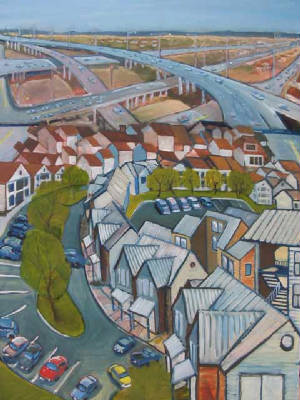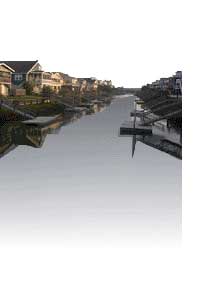|
In many respects the Los Angeles region, which includes the San Fernando Valley is highly centralized around its core,
the City of Los Angeles. In other respects, Los Angeles is very dispersed and fragmented, often described as “100 suburbs
in search of a city.” This observation is especially true of the residential and commercial districts. Although outlying
cities once may have been considered suburbs of the City of Los Angeles, today the metropolitan area consists of literally
hundreds of central business districts, each surrounded by suburb-like rings, which fade again into adjacent downtowns.
Many neighborhoods of Los Angeles in the San Fernando Valley have 'seceded' from one another
in the form of renaming and reforming known community boundaries. Groups are motivated by the desire to disassociate themselves
from undesirable connotations that some communities have inherited and, in the process, increase property values. lake
Balboa recently broke away from Van Nuys. Valley Village and Valley Glen separated from North Hollywood. West Hills
and Winnetka from Canoga Park. Porter Ranch seceded from Northridge. Arleta successfully broke off from Pacoima but
was thwarted in its attempts to carve out a separate ZIP code. The separate districts are in name only as none of the
communities have actual governmental authority and all of the communities remain politically a part of the City of Los Angeles.
Despite the San Fernando Valley's reputation for sprawling, low-density development, the Valley
communities of Panorama City, North Hollywood, Van Nuys, Reseda, Canoga Park, and Northridge, all in Los Angeles,
have numerous apartment complexes and contain some of the densest census tracts in Los Angeles.
Latinos and non-Hispanic whites are nearly even in numbers, combining to comprise more
than four out of five Valley residents. In general, communities in the northeastern, central, and northwestern parts of the
Valley have the highest concentration of Latinos. Non-Hispanic Whites live mainly along the communities along the region's
mountain rim. The city of Glendale has an influential and very large Armenian community. The cities of San Fernando, Calabasas,
Hidden Hills, and the Tarzana area of Los Angeles are quite homogeneous in racial makeup.
Asian Americans make up 10.7% of the population and live throughout the Valley, but are
most numerous in the city of Glendale and the Los Angeles communities of Chatsworth, Panorama City, Porter Ranch, and
Granada Hills. African Americans compose 5.1% of the Valley's population, living mainly in the Los Angeles sections
of Lake View Terrace, Pacoima, Reseda and Chatsworth. Another large ethnic element is the Iranian community
with 200,000 people living mainly in west San Fernando Valley.
Poverty rates in the San Fernando Valley are lower than the rest of the county (15.3% compared
to 17.9%). Eight San Fernando Valley communities have at least one in five residents living in poverty.
The Pacoima section of Los Angeles is widely known in the region as a hub of suburban blight.
Other San Fernando Valley communities, such as the Los Angeles sections of Mission Hills, Arleta, and Sylmar, have poverty
rates well below the regional average, even lower than neighborhoods populated by a higher number of Nonhispanic White residents.
Many wealthy families live in the hills south of the Ventura Boulevard; as a
result, the phrase "South of the Boulevard" has become a commonly used buzzword in local real estate.
The valley's pastoral setting began to give way to a more urban
and suburban environment, spawning the cities of Burbank, Glendale, and San Fernando, and the unincorporated neighborhoods
of Encino, Tarzana, Northridge, Chatsworth, and Sherman Oaks.
A predominantly upper-middle class community, Burbank is home to many employees of the
motion picture and television studios located in and around the city. Entertainment has generally replaced the defense industry
as the primary employer of its citizens, who are attracted by the relative safety and security offered by its own police and
fire departments, highly rated schools and hospital. Other reasons cited are its small-town feel while located only
10 minutes away by car to the hip clubs and restaurants of Hollywood.
How "Valleywood" Came To Be...
Another reason the Valley became famous was the arrival of movie makers. They adored the varied terrain,
historic ruins and predictably sunny weather. Cinema legends D.W. Griffith and Cecil B. DeMille discovered the Valley and
shot many early movies there, then bought ranch getaways in the canyons. Around studios like Universal, Warner Brothers and
Republic, a movie colony grew.
Stars like Bob Hope and Bing Crosby golfed and gagged around in Toluca Lake, while Clark Gable and
Al Jolson made Encino ritzy. In the west Valley were the stars who favored the ranch life: James Cagney, Barbara Stanwyck,
Lucille Ball and Desi Arnaz among others. Ronald Reagan was one of the actors who lived the life of a San Fernando Valley
rancher.
The presence of all these celebrities and the stories they told about living the good life sold an image of
the Valley as a sort of paradise. National magazines helped feed the myth and the Valley continued to lure more people.

SUBURBAN SAN FERNANDO VALLEY
“The San Fernando Valley serves, in fact, as the nation’s
favorite symbol of suburbia run rampant. It is the butt of jokes for its profligate sprawl, kooky architecture, unhip
telephone area code and homegrown porno industry, as well as for a mythical tribe of nasal-toned, IQ-challenged teenage girls
who like to shop. And yet the Valley only became a suburb fairly late in its history, and whether it qualifies for the label
anymore is arguable.
Its formal identity
is as an oversized appendage of the city of Los Angeles, but that does not tell the real story. The expansive, gently pitched
plain has been a destination in at least four centuries now, a landing place for travelers who picked up their lives in search
of something better. Where backyard barbecues now reign, two Native American cultures met to celebrate holidays together.
The name El Valle de San Fernando was bequeathed by colonizers who came from Spain to civilize the Indians and to carve
up the land. Later waves of settlers came to escape from shattering winters in cities like Philadelphia and Buffalo, or to
try their luck at growing walnuts, or at building airplanes or helping invent the new medium of television. And still they
come, from New York and Austin, but more often now from Seoul and Tehran and Guadalajara.
All are seeking their piece of the American dream in what
has become one of the most richly diverse corners of the country. Once here, they find the miles of walled subdivisions, wide
boulevards and corner strip malls that fit with the Valley's popular image as a stucco haven -- as well as the million-dollar
estates, ethnic enclaves and urban forest of exotic trees and shrubs that suggest a more textured story.
Newcomers are often startled to discover signs of a rural
past. Pockets of dirt streets and horse trails remain, along with faded farmhouses, backyard chicken coops, gurgling creeks
and overgrown orchards, if you know where to look. This should be no surprise. At the start of the 20th century, the Valley
floor contained the world's largest wheat farm, biggest citrus orchardand grandest grove of producing olive trees. The population
was scant, just a few thousand, among them Basque sheepherders, Italian orange growers, Japanese strawberry pickers and Midwestern
homesteaders. Horse-drawn stages still rattled through a winding mountain pass to Los Angeles.
Some 1.7 million people, more than the population of twelve
states and about a third of the Los Angeles population, now reside in the Valley. More than a third of them were born in another
country. But some things never change. These denizens of the Valley still live a largely separate existence from their fellow
Los Angelenos. They don't share the same climate, flora or fauna, or much of a common history. The two hemispheres of the
city have been joined only for a fraction of the Valley's existence -- and then only in an audacious arranged marriage recognized
in fiction in the film Chinatown, but which in real life has yet to be fully consummated.”
Excerpts from The San Fernando Valley: America's Suburb by Kevin
Roderick.
NEIGHBORHOODS IN THE VALLEY
|
Unincorporated communities
|
|
|
| |
Communities and Neighborhood in the Valley
|
|
Arleta *Balboa Park *Cahuenga Pass *Canoga Park *Chatsworth *Encino *Granada Hills *Knollwood *Lake View Terrace *Lake Balboa
*La Tuna Canyon *Mission Hills *NoHo Arts District *North Hills *North Hollywood *Northridge *Pacoima *Panorama City *Porter
Ranch *Reseda *Sepulveda *Shadow Hills *Sherman Oaks *Studio City *Sun Valley *Sunland *Sylmar *Tarzana *Toluca Lake *Toluca
Woods *Tujunga *Valley Glen *Valley Village *Van Nuys *Ventura Business District *Warner Center *West Hills *West Toluca *Winnetka
*Woodland Hills
|
*The westernmost neighborhoods in the city of Glendale are within the San Fernando Valley, but the majority of the city lies outside the Valley.
|
| |
| |
| |
|
